|
FAQs about Dendrophylliid Coral Behavior
Related Articles: Dendrophylliid Corals,
Related FAQs: Dendrophylliids 1, Dendrophylliids 2, Dendrophylliid Identification, Dendrophylliid Compatibility, Dendrophylliid Selection, Dendrophylliid Systems, Dendrophylliid Feeding, Dendrophylliid Disease, Dendrophylliid Reproduction, Stony/True Coral, Coral System Set-Up, Coral System Lighting, Stony Coral Identification, Stony Coral Selection, Coral Placement, Foods/Feeding/Nutrition, Disease/Health, Propagation, Growing Reef Corals, Stony Coral Behavior,
|
.JPG)
|
Dendro Heads Separating 10/21/18
Hello WWM, Recently a handful of my Dendro frags have grown multiple heads.
I have noticed the tissue has been receding between the heads on all the frags.
Other than the tissue receding the heads look good with full tentacle extension
and eating normally. Is the tissue receding a normal characteristic when
multiple heads grow?
<Not really... something is likely lacking; insufficient. Do you feed your stony
corals? Light in balance? Enough alkaline earths in proportion, alkalinity....?
A good clue might well be what else you have in the system that is doing well.
Bob Fenner>
Eric
|
Balanophyllia hiding
7/19/18
Hi Crew!
<Hi Dani>
I rebooted my tank about 4 months ago, kept most liverock, rinsed sand bed,
added some new rock, and slowly restocked corals.
<Great>
I picked up a Balanophyllia which was opened at the store with their daylights
on. I acclimated it for about 3 hours, dripped acclimated, bathed in revive, and
placed mid-low level with mid-low flow.
It neither ate for almost a week nor extended any tentacles. I tried pellets,
Mysis, and a slurry of zooplankton even—nothing. It seemed to actually slime off
the food. So I tried a larger food like krill and shredded a piece, and laid it
on the balano. The first time it slowly—over like 20 minutes—but definitely ate
it.
<Try foods like live or defrosted brine shrimp, Mysis shrimp, and other similar
sized prey. Soaking the food in a vitamin supplement can help to ensure your
coral gets plenty of nutrients; you need to feed it at least once a day, if
needed use a turkey baster to target the food directly on the Balano without
touching it or it may not open/eat, turn off your pumps several minutes during
feeding so the food does not go elsewhere. >
So everyday I have been carefully feeding it the shredded piece of krill. Seems
to get a tiny bit faster eating each day. It pops like one tiny tentacle out now
at random times but that’s it. Do you think it is still settling in or should I
be concerned?
<As long as it is not bleaching out, you are fine here, do bear in mind this is
a difficult species to keep in captivity, it is not photosynthetic, so, as
stated it needs to be fed regularly.>
Tank is a JBJ 28,
LED 89w par intensity up to 700
2 returns @ 266 gal each
1k icecap gyre at 80% power (800 gph set at random mode, alternating flow, and
pulse [this thing is fantastic])
SG 1.025
Am 0
Nitrite 0
Nitrate <5
Alk 12
Calcium 460
Mag 1440
I feed tank everyday except water change day—2 days frozen fish eggs/Mysis and a
dose of zooplankton, the rest of the days pellets, and finally balano gets it’s
piece of krill.
I do a 25% water change weekly.
<A 10% water change weekly will be enough, less stressful and will replenish
needed additives and trace elements.>
My sandbed seems to get dirty though even with my Nassarius snails going through
it so sticking to weekly at the moment. Hoping it may stabilize where I can do
biweekly one day, want to ensure my sps and lps get more of a chance to absorb
some food from water column.
Thank you for any feedback!
<You are welcome. Wilberth>
Dani
|
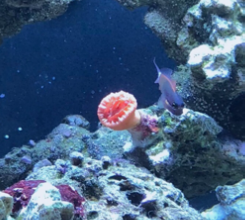
|
Re: Balanophyllia hiding
7/26/18
Happy to report that after getting it to eat more, the balano now comes out and
not just at night but during the day lighting too! ☺️
<Great! I can see that in this very nice picture>
One question on your response though that has had me really pondering—why only a
10% weekly water change?
<10% weekly is enough to keep balance without disturbing tank inhabitants and
the biofilter, “Old water” with parameters at nontoxic/safe levels is what you
should aim for.>
Pardon my ignorance, is it not better to remove as much organics possible with
each change or maybe that’s not such a concern because my tank is more balanced
now?
<As you said, it’s not a major concern on balanced systems, just keep good
maintenance practices and avoid overstocking and overfeeding>
I definitely don’t want to be stressing my aquatic friends and in fact I’d love
to cut down to maybe a larger change every other week? Or is it better with
smaller changes every week? Just curious about the logic to this if you could
please share.
<Always better to do small frequent changes, just don´t skip them>
Dani
<Wilberth>
|
.jpeg) |
|
Euphyllia and
Duncanopsamia
3/13/12
Dear WWM,
First, my Duncan coral has developed some bulges around
its base. They appear to have tentacles and a mouth. I believe they are
more Duncan polyps.
<Let's hope so>
I have only had this coral for about two months though, would
this be a sign that something is wrong or right?
<More right>
I think it is a good sign, but I heard that Anemones will split
sometimes before death.
<Yes... a bit different proposition... as they can move, "get
away"; not so Scleractinians>
I have been feeding it. Next, I have a beautiful Torch coral which has
doubled in size.
The problem is that I also have a Bubble Coral. The Bubble Coral has
decreased by almost half. I think it is losing to chemical warfare.
<Quite likely>
I was thinking about moving it to a small tank which is only about
twelve inches high. It would be under NO lights. I know that they feed
more than photosynthesize, but I don't want to kill it by keeping
it where it is or moving it to an unsuitable environment. Should I
donate it? Something?
Have a wonderful week!
Bryce
<I would definitely be moving it somewhere else in any case. Bob
Fenner>
|
Please help identify Yellow "Growth" on Sun
Coral 5/8/11
Hi,
<Hello Brian>
I have several Sun Corals one of which has developed a yellow
growth over it's surface over the last few days.
<I see this...>
The sun coral is not opening up well in the area affected.
I have been to my local stores where I purchase coral with
pictures however, they could not identify what this is.
Suggestions made have been either a fungus, a sponge, or a
secretion from the sun coral itself.
<The latter almost assuredly. I thought/feared this might be
some sort of matter "left over" from
Wendletrap/Epitonium reproduction, but am now thinking
"something" disturbed these polyps sufficiently for
them to "throw up" their mesenterial filaments>
If you could help identify and suggest a course of treatment it
would be greatly appreciated.
<Seek out the source/pattern of the upset. Another Cnidarian
perhaps? Do you have an errant Anemone in this system? Did
someone drop a dry "supplement" of some sort on this
area? No "treatment" advised. Bob Fenner>
Thank You Brian Hunter
|
|
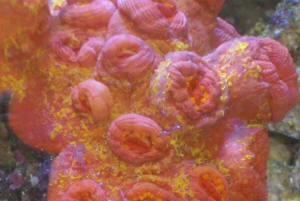 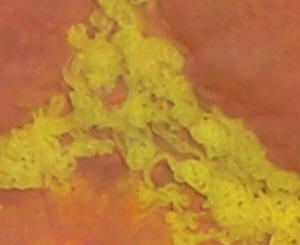
|
|
Re: Please help identify Yellow "Growth" on
Sun Coral 5/9/11
Thank You,
<Welcome>
I did finally come across another photo which looked exactly like
mine did. It was posted to a forum for help. Several answers came
back that it was perfectly normal and that they believed it was
related to overeating by the sun coral.
Brian Hunter
<Mmm, well, I don't think it's "lethal
behavior", but is not "normal"...
i.e. I've never encountered this on the many occasions of
observing Tubastrea spp. in the wild. Cheers, BobF>
|
Duncan's coral not opening
4/26/10
Hello Crew,
<Wayne>
I have a Duncan's coral with about 30 heads on the colony which I
have had for about a year. It has been sitting in it's current
location for several months now and it has been opening up quite large,
extending it's tendrils and eating well. About a week ago it
stopped opening as fully and opened less each day until it is finally
not opening at all. The nearest corals are about 6-8 inches away (some
Xenia, Green Star Polyps, Green Sinularia)
<These can/will "all do it">
and there are some Zoanthids at least 12 inches away.
<Ditto>
I have not added any new corals for over 8 months. I am doing regular
water changes and all my other corals are quite happy. The only thing
that comes to mind is that I have not replaced my T5 bulbs in over 6
months and perhaps their light output has shifted. My alkalinity is at
3 mEq/L and pH is about 8.2.
Ammonia is zero, phosphates are not detectable, calcium is about 400
mg/L.
I have not tested for Mg. I did however start adding Purple Up about
every 3 days at the recommended rate a few weeks ago. Would you be able
to suggest some other possible causes which may be aggravating my
Duncan's
colony?
<It's the big loser here... Read: http://wetwebmedia.com/cnidcompppt.htm
and the linked files above, and onto Dendrophylliid Comp. FAQs... There
are a few techniques that may save this colony... else, I'd be
moving it some place different... another system. Bob Fenner>
Thank you and best regards,
Wayne
|
Dendrophylliids, leaving skeleton! --
07/01/09
Hi do you know if Dendrophylliids ( sun- flower Corals ) leave
the corallite structure and crawl around the tank?
<I do... and they don't>
Our sunflower corals have all crawled out of the corallites
structures .
<Trouble. See WWM re the family's needs, health. Something
is very wrong here. Bob Fenner>
Thanks for your help Ivan
Re: Dendrophylliids 7/14/2009
Hi Bob attached find photos of Sun-flower corals
Regards Ivan
<Interesting to speculate that this might be a "coral
polyp bail out" mechanism that allows for relocation...
rather than death... for immobile stony corals... Thanks for
sharing, Bob Fenner>
|
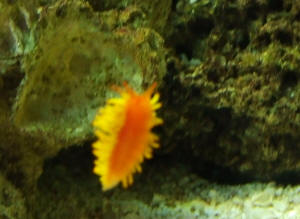 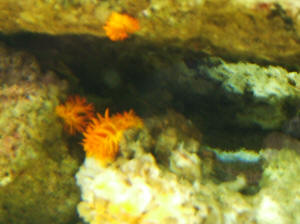 |
Turbinaria reniformis, beh. 4/20/08 Let me
start by saying thank you for the wonderful website.... Brilliant. I
have one question about a frag I bought for my LPS/SPS reef tank. It is
a Turbinaria (orange with yellow polyps). I have done some
research on this species and I am a little confused about the polyp
extension on this coral. Mine has its polyps out all the time,
throughout day and night. From what I understand this is abnormal,
should only be out during the night. could it be "hungry", I
feed live phyto, red Colonus Plankton, and Cyclops for corals) Is this
anything to worry about? <Mmm, no... not to worry. This and most all
overtly zooplanktonic/feeding corals do go "acyclic" for a
while, eventually adapting to "captive conditions"... not to
worry re this Dendrophylliid> All parameters are good: Tank is 18
months old Salinity: 1.024 Temp: 80 Calcium: 400 Alkalinity: 10 DKH PH:
8.13-8.45 day/night (no fuge but try to keep stable with dripping Kalk
at night) Mag: 1290 Strontium: 14mg/L Nitrate: 3 PPM Phosphate:
undetectable (no algae problem and feed sparingly) I would say it grows
about 1/4 of an inch in a months time, and has never shown any signs of
it being unhealthy. (although when I got it I had to siphon off about 8
of those lovely, tiny, purple/pink Nudibranchs) Must all be gone...
have not seen any in a couple months. Okay maybe 2 questions. I have
also read that they do not need "that much light" as far as
LPS?/SPS corals go. My tank has two lamps and is a standard 75gal.
aquarium. 1 PC=260W (130W-10K and 130W-420nm actinic) 1 T5HO 216W
(108W-10K and 108W-14K) for a grand total of 476W. A. Does this sound
like a good lighting combo for a mixed reef. (no softies except for
some green Mushrooms and 13 orange Rhodactis Mushrooms. All placed at
the bottom) Everything else is light loving. <Is fine> B. The
Turbinaria is about 10 inches from the surface. Should it be moved
lower in the tank? <I would leave this colony where it is... Is
evidently doing well, judging from the growth rate...> And sorry but
I just keep thinking of more questions. As I stated, my tank is mostly
SPS/LPS with the exception of a very large LTA. (I know, I know.... no
anemones in reef tanks right. <Mmm, can be done... with care> It
does not move and has pretty much 1/3 of the tank dedicated to it, so
nothing gets stung.) I also have a Skunk Cleaner Shrimp and the usual
hermits, snails, and other clean-up crew and a Sand-sifting star that
has been alive and well for over a year, I have a 6inch DSB. I do not
dose any Iodine/Iodide, but do a 10 gallon water change with Red Sea
Coral Pro salt and RO water every week. (By the way, have you guys at
WWM heard anything about this salt yet. <Just bits and pieces.
Appears to be a fine product> I have used your search bar and so far
I have not found any opinions on it because it is so new, but I have
gone through a whole 65lbs. bucket and I don't want to switch so I
am just looking for somebody to tell me it is okay to keep using it. I
am far from an expert, but I just have to say I love it. All parameters
check out when I tested the freshly mixed water after a 24 hour cycle
period. Also all corals look absolutely beautiful right after a water
change.) Should this be enough to keep Iodine at a respectable level?
<Likely so. If, when in doubt, some mix of Iodine/ide/ate can be
added w/ exceedingly little chance of trouble> Should I invest in a
test kit for this and look into Lugol's Iodine? <If you'd
like> My shrimp molts every couple of weeks, so that is a good
sign...right? <Yes...> Thank you for your help, and props to
Anthony Calfo and Bob for the wonderful Book of Coral Propagation.
<Ahh, this work is Antoine's alone... and the second ed.
especially re-done very well. Cheers, Bob Fenner>
|
Sun Coral Observation, Dendrophylliid beh.
11/14/07 Hello Crew, <Sara> I just wanted to share an
observation and see what you all think. I recently added a few
small sun coral colonies to my aquariums. One of them appeared to
be getting some sort of disease. There was a line of red/maroon
colored "ooze" moving over some of the polyps (at an
alarming pace). Of course, I first thought it must be brown jelly
disease (or something like that). So I freaked out and fragged
off the effected polyps. Much to my dismay, that didn't work.
The red slime/ooze appeared to start moving over the rest of the
polyps of this colony. But this time I just resigned to watching
it die (though I did blow off the "red stuff" several
times a day and continued to feed the coral like I did the others
anyway--even though the polyps weren't extending). Then I
noticed something strange. After this slime/ooze/disease had
moved over just about all the polyps, it just stopped and
disappeared. Stranger still, the polyps which had been effected
weren't at all dead as I had initially thought. They were
very much still alive (but with a lighter shade of tissue and
shorter tentacles). I was both elated that the coral wasn't
dead and sad that I'd fragged off polyps that might not have
been doomed (I really do have to remember not to be so
Dremel-happy). The coral is now doing pretty well as far as I can
tell and this "disease/condition" never spread to the
other colonies. If I didn't know better, I swear I'd
think the coral just "shed." <Perhaps... but the
question comes... of what "use" is such behavior... is
it a reaction?> Any idea what might have been going on here?
I'm sorry I don't have any pictures, but this all
occurred over the course of not even 3 days. Thank you, Sara
<Thank you for sharing. BobF>
Re: Sun Coral Observation -11/14/07
<Perhaps... but the question comes... of what "use"
is such behavior... is it a reaction?> <<I honestly
don't know. The whole thing baffles me. If I had to guess,
thinking of why other corals "shed," is that maybe
it's a reaction to an external irritant? I believe leather
corals sometimes shed to prevent algae from growing on them. And
I've read literature which suggests even some coralline algae
"shed" to prevent fouling. The speed with which this
happened, and how rapid the coral "recovered" (within
days) makes me skeptical that it's a disease. But who knows?
The lack of information/research is a bit frustrating. Sara
M.>> <And/or enthralling... How could/would one test
these hypotheses? B>
Re: Sun Coral Observation -11/14/07
<And/or enthralling... How could/would one test these
hypotheses? B> <<Well, I suppose one way to start
investigating would be to try to induce it with different
stimuli. But before I start torturing my corals, I think I'll
ask around to see if anyone else has seen this and when/why they
think it happened. :-) -S.M.>> <Hotay. B>
|
Need help pagoda coral 8/7/06 I recently
bought a pagoda coral and placed it in my 20 reef. <Small....>
Its been 2 days <Often takes several days for cnidarians to
acclimate...> and hasn't fully open only halfway open its pretty
high in the tank with lots of water flow my lighting is on this tank is
2 55 watt pc at the pet store they are using metal halides and coral
was placed on top checked my parameters and they are all good I
don't know what I should do any help would be appreciated thanks
<Please read here: http://wetwebmedia.com/dendrophylliidae.htm
and the linked files above. Bob Fenner>
Pagoda Help I've had a pagoda for about 2 weeks and
I just saw the strangest thing yet. A brownish stringy slime was
discharged from every polyp (which have not been opening very much).
This stringy slime was floating around the tank and I netted a lot of
it out, but what is it? Is it a poison, signs of the pagoda dying or
doing poor, or just its natural waste cycle. Thanks, Michael <Likely
a natural "exudate", reaction product to something (likely
living) in the same system... It is a good idea to try and remove this
material as you state... I would also check what you can water quality
wise, refresh your activated carbon, and be prepared to execute a
larger water change with pre-made water should other livestock show
signs of distress. Bob Fenner>
Tubastrea (sun polyps) losing color -
2/17/05 Hello Crew! <Hey Elmer> I must say that I'm an
avid reader of your web site, learning a lot of things. <Great! Me
too, actually> Thanks for that. <Thanks for coming here and being
part of it all. It is why we do what we do> I have a beautiful
sun/tube coral (Tubastrea aurea) which is in my aquarium for about 3
months now. <Fed well I hope?> I noticed that it started to lose
its orange color at the base of its tubes. <Fading or actually
turning colors?> It started as one spot three weeks ago that is
gradually enlarging through time. <Hmmmm> Now, most of the bases
and in between the tubes are grayish in color. <How is the flow
around this coral??> Is this a sign of a dying coral? <Very
possible. How do you feed this coral? This is a non-photosynthetic
coral so it will need feeding somewhat frequently. At least every three
to five days> It is sitting at the bottom of my aquarium, not in a
shaded area. <Not necessarily an issue but I have usually spotted
these corals growing caves and overhangs usually upside down> My
water parameters are very good. <OK Be sure to check it and maybe
even have someone check if possible. Maybe a local fish store?> I
have a 50g aquarium (5 months old), 192w fluorescent lighting, Arctica
chiller maintained at 77F, 60lbs live rock, CPR Cyclone CY 194
sump/skimmer/filtration system with carbon, RowaPhos, and BioBale
inside. <You can take out the BioBale if you would like, otherwise
sounds very nice> I have a flame angel, yellow tang, 2 damsels, a
Banggai cardinal, 2 soft corals, 2 LPS corals, a starfish, and 2
cleaner shrimps. <Good selection. Keep an eye on the damsels.
Destructo twins for sure> This tube coral is my first coral. It is
beautiful and I earnestly don't want to lose it. <Again, be
aware they like a medium flow and need to be fed regularly as stated
above. Try a mixture of various Mysid, Cyclops-eeze, baby brine, Omega
one etc and try target feeding if you don't already. Very likely
they do get some food left over from the fish feedings but better to
target. Again, to reiterate, this is not a coral that requires
lighting.> It still continues to expose its yellow tentacles at
night time. <A good time to feed it> Please advise. <I
can't say for sure that this coral is dying, but I think increase
the flow, maybe hang it in an overhang or cave, and target feed when
tentacle are exposed will get the coral back on track.> Many thanks
for your help. <Hopefully I have helped. Remains to be seen. Thanks
for being part of it all. ~Paul> Regards,
Elmer
|
|

